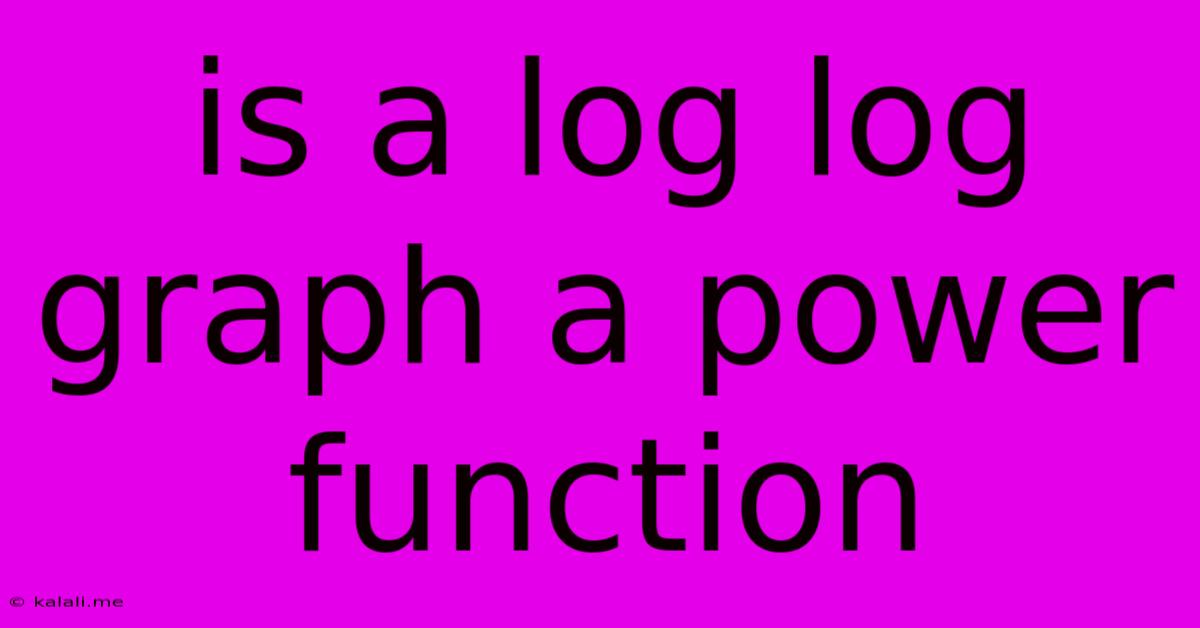Is A Log Log Graph A Power Function
Kalali
May 30, 2025 · 3 min read

Table of Contents
Is a Log-Log Graph a Power Function? Deciphering the Relationship
Log-log graphs are invaluable tools for visualizing and analyzing data, particularly when dealing with relationships that span several orders of magnitude. A common question arises: Does a straight line on a log-log graph always indicate a power function? The answer, while mostly yes, requires some nuanced understanding. This article explores the relationship between log-log graphs and power functions, clarifying the conditions under which a straight line signifies a power function and what to look out for when interpreting results.
Understanding Power Functions
A power function is defined as a function of the form y = ax<sup>b</sup>, where 'a' and 'b' are constants. These functions describe relationships where a proportional change in x results in a proportional change in y, raised to the power of 'b'. Examples include the area of a circle (proportional to the square of the radius) or the volume of a sphere (proportional to the cube of the radius).
Log-Log Transformation and Linearization
The magic of log-log graphs lies in their ability to linearize power functions. Taking the logarithm of both sides of the power function equation:
log(y) = log(ax<sup>b</sup>) = log(a) + b*log(x)
This transformed equation is in the form of a linear equation: Y = A + bX, where Y = log(y), A = log(a), and X = log(x). This means that plotting log(y) against log(x) will produce a straight line if the original data follows a power function. The slope of this line is equal to 'b' (the exponent in the power function), and the y-intercept is equal to log(a).
When a Straight Line on a Log-Log Graph DOES Indicate a Power Function:
- Linearity: The most crucial factor is a clearly defined straight line. Deviations from linearity suggest the relationship isn't purely a power function. Minor deviations might be acceptable due to noise or measurement error, but significant curvature implies a more complex relationship.
- Appropriate Data Range: The data should cover a sufficient range of x and y values to confidently establish the linearity. A straight line observed over a small portion of the data may not extrapolate accurately to other ranges.
- Data Transformation: The process of taking logarithms should be appropriately applied. Negative values will require adjustments or alternative approaches.
When a Straight Line on a Log-Log Graph MIGHT NOT Indicate a Power Function:
- Coincidence: A seemingly straight line might be coincidental, particularly with limited data points. A more extensive dataset or further analysis might reveal a different underlying relationship.
- Nonlinearity over a Wider Range: A seemingly linear relationship observed over a limited range might become nonlinear as the range extends. Therefore, it's crucial to consider the entire data range available.
- Data Errors: Significant errors or outliers in the original data can distort the log-log plot, potentially masking the true relationship. Careful data cleaning and outlier analysis are vital.
Beyond the Straight Line: Exploring More Complex Relationships
While a straight line on a log-log graph strongly suggests a power function, other relationships can also produce near-linear patterns. These situations require a deeper investigation. Consider these scenarios:
- Piecewise Power Functions: Data might follow different power functions across different ranges.
- Power Functions with Added Constants: A power function with additional constant terms (y = ax<sup>b</sup> + c) will not perfectly linearize on a log-log plot.
- Other Functional Forms: Some other functional forms can yield approximate linearity in log-log plots.
In Conclusion:
A straight line on a log-log graph is a strong indication of a power function relationship between variables. However, careful consideration of data range, potential errors, and the linearity's robustness are necessary before definitively concluding that a power function describes the data. Always critically assess the plot's features and consider the possibility of more complex relationships. Further analysis, including statistical tests and alternative modeling approaches, might be needed for a complete understanding.
Latest Posts
Latest Posts
-
Effective Mass Of Electron In Silicon
May 31, 2025
-
How To Connect A 3 Way Switch
May 31, 2025
-
How To Fix Too Much Pepper In Soup
May 31, 2025
-
Thank You So Much Or Very Much
May 31, 2025
-
How Old Was Solomon When He Asked For Wisdom
May 31, 2025
Related Post
Thank you for visiting our website which covers about Is A Log Log Graph A Power Function . We hope the information provided has been useful to you. Feel free to contact us if you have any questions or need further assistance. See you next time and don't miss to bookmark.